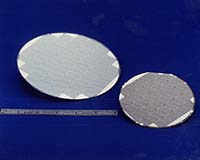 |
Washington DC (SPX) Dec 10, 2010 A new laser-beam steering system that aims and focuses bursts of light onto single atoms for use in quantum computers has been demonstrated by collaborating researchers from Duke University and the University of Wisconsin-Madison. Described in the journal Applied Physics Letters, published by the American Institute of Physics, the new system is somewhat like the laser-light-show projectors used at rock concerts and planetariums. But it's much smaller, faster, atom-scale accurate and aimed at the future of computing, not entertainment. In theory, quantum computers will be able to solve very complex and important problems if their basic elements, called qubits, remain in a special "quantum entangled" state for a long enough time for the calculations to be carried out before information is lost to natural fluctuations. One of several promising approaches to quantum computing uses arrays of individual atoms suspended by electromagnetic forces. Pulses of laser light manipulate the internal states of the atoms that represent the qubits, to carry out the calculation. However the lasers must also be focused and aimed so accurately that light meant for one atom doesn't affect its neighbors. The new system did just that. Tiny micromirrors, each only twice the diameter of a human hair, pointed to each target atom in as little as 5 microseconds, which is about 1,000 times faster than sophisticated beam-steering mirrors developed for optical communications switching, not to mention the still slower units used in light shows. The researchers saw that the laser pulses also correctly manipulated the quantum properties of each target atom - in this case a line of five rubidium-87 atoms - without disturbing any neighboring atoms, which were separated by just 8.7 microns, about one-tenth the diameter of a human hair. "Our experiments demonstrated the crucial requirement that our micromirror system maintain the laser-beam quality necessary to manipulate the internal states of the individual atoms," said Jungsang Kim, leader of the Duke researchers who designed the micromirror system. The atomic physics experiments were performed in Mark Saffman's group at University of Wisconsin-Madison. The groups plan to continue their collaboration, with future experiments targeting two-qubit gates, which are expected to be the basic building block of quantum logic, and atoms confined in larger two-dimensional arrays. The article, "Independent individual addressing of multiple neutral atom qubits with a micromirror-based beam steering system" by Caleb Knoernschild, Xianli Zhang, Larry Isenhower, Alex T. Gill, Felix P. Lu, Mark Saffman, and Jungsang Kim appears in the journal Applied Physics Letters.
Share This Article With Planet Earth
Related Links American Institute of Physics Computer Chip Architecture, Technology and Manufacture Nano Technology News From SpaceMart.com
 Rice Physicists Discover Ultrasensitive Microwave Detector
Rice Physicists Discover Ultrasensitive Microwave DetectorHouston TX (SPX) Dec 10, 2010 Physicists from Rice University and Princeton University have discovered how to use one of the information technology industry's mainstay materials - gallium arsenide semiconductors - as an ultrasensitive microwave detector that could be suitable for next-generation computers. The discovery comes at a time when computer chip engineers are racing both to add nanophotonic devices directly to ... read more |
|
| The content herein, unless otherwise known to be public domain, are Copyright 1995-2010 - SpaceDaily. AFP and UPI Wire Stories are copyright Agence France-Presse and United Press International. ESA Portal Reports are copyright European Space Agency. All NASA sourced material is public domain. Additional copyrights may apply in whole or part to other bona fide parties. Advertising does not imply endorsement,agreement or approval of any opinions, statements or information provided by SpaceDaily on any Web page published or hosted by SpaceDaily. Privacy Statement |